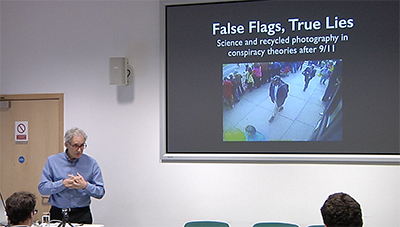David Hickman - 11 November 2014 - False Flags, True Lies: Science and Recycled Photography in Conspiracy Theories after 9/11
Preview not available - media data has been uploaded to this media item, but it has not been transcoded yet.
About this item

| Description: |
How can we reconcile the sense that recent conspiracy theories can appear – to put not too fine a point on it – crazy, and clear evidence that they have had a broad, if often transient, appeal?
Since 9/11, a succession of conspiracy theories have alleged that major incidents like the Aurora cinema shooting, the Sandy Hook massacre, the Boston marathon bombing and, of course, 9/11 itself, were actually ‘false-flag’ plots by secret government agencies – or some entity that might be called a ‘deep state’ – designed to pursue certain ideological objectives (the withdrawal of civil liberties, the repeal of the right to bear arms, the assertion of a supranational power). All of these theories have (to borrow a phrase) a ‘family resemblance’, and share two characteristics in particular: a recourse to scientific narrative as ‘proof’ of a conspiracy, and an appeal to some underlying ‘truth’ in photographic evidence. And in both, there is the same uncoupling: scientific discourses can be deployed to undermine corrupt, ideologically distracted scientists; and photography is routinely capable of revealing hidden truths, even when the instruments of photography are controlled by a venal, manipulative mass media. However, such ideas (and suspicions) are not confined to conspiracy theories; they are commonly expressed, both in a perceived decline of scientific ‘expertise’, and in the tenets and accumulated assumptions of postwar photographic realism. It may be that these ways of seeing, rather than the conspiracy theories themselves, present the most urgent democratic challenges. |
|---|
| Created: | 2014-11-21 10:13 |
|---|---|
| Collection: |
Conspiracy and Democracy
Conspiracy and Democracy |
| Publisher: | University of Cambridge |
| Copyright: | Glenn Jobson |
| Language: | eng (English) |
| Distribution: |
World
|
| Keywords: | CRASSH; David Hickman; Conspiracy and Democracy; |
| Explicit content: | No |
| Aspect Ratio: | 16:9 |
| Screencast: | No |
| Bumper: | UCS Default |
| Trailer: | UCS Default |
| Abstract: | How can we reconcile the sense that recent conspiracy theories can appear – to put not too fine a point on it – crazy, and clear evidence that they have had a broad, if often transient, appeal?
Since 9/11, a succession of conspiracy theories have alleged that major incidents like the Aurora cinema shooting, the Sandy Hook massacre, the Boston marathon bombing and, of course, 9/11 itself, were actually ‘false-flag’ plots by secret government agencies – or some entity that might be called a ‘deep state’ – designed to pursue certain ideological objectives (the withdrawal of civil liberties, the repeal of the right to bear arms, the assertion of a supranational power). All of these theories have (to borrow a phrase) a ‘family resemblance’, and share two characteristics in particular: a recourse to scientific narrative as ‘proof’ of a conspiracy, and an appeal to some underlying ‘truth’ in photographic evidence. And in both, there is the same uncoupling: scientific discourses can be deployed to undermine corrupt, ideologically distracted scientists; and photography is routinely capable of revealing hidden truths, even when the instruments of photography are controlled by a venal, manipulative mass media. However, such ideas (and suspicions) are not confined to conspiracy theories; they are commonly expressed, both in a perceived decline of scientific ‘expertise’, and in the tenets and accumulated assumptions of postwar photographic realism. It may be that these ways of seeing, rather than the conspiracy theories themselves, present the most urgent democratic challenges. |
|---|---|
